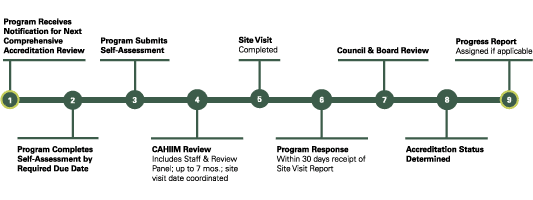Health Information Management
Health information management is the practice of managing medical information vital to providing quality patient care, sound fiscal management of medical resources, and data governance supporting confidentiality of patient records. Management of this data includes acquisition, analysis, and protection of digital and traditional types of information.
Health Information Management Accreditation
Health Information Management education occurs in academic programs awarding associate, baccalaureate, and master’s degrees. Each of these degree programs has a set of accreditation standards that ensure the quality of the education. Graduation from these education programs are the beginning of a career in health information management.
Health Information Management professionals may practice in health care, health information systems industry, health information management education programs, health finance and billing services, and health information standards and policy development. Their practice connects clinical, operational, and administrative functions in health care. They work on the classification of disease and interventions to ensure their standardization for use in clinical, financial, and legal purposes.
Standards – Future Education Model (FEM)
Health Informatics Accreditation Standards
Future Education Model

CAHIIM is leading the development and validation of new competencies; and are revising the HIM Education Accreditation Standards to support an evolving competency-based education(CBE) framework.
The goal of the initiative is to develop and validate a new set of competencies and accreditation standards for each HIM degree level, ensuring role delineation, future practice relevance, and alignment with a new competency-based framework.
For all questions, needs, or concerns related to the Future Education Model (FEM), please click the link below to submit your question to CAHIIM.
Accreditation Standards
CAHIIM recently released the new HIM Accreditation Standards and associated competencies for all degree levels. Education programs will work to full compliance with the new accreditation standards by September 2026.
To support the transition of this new education model, CAHIIM will offer training sessions and accreditation guidance materials and is launching a Future Education Model (FEM) Demonstration Program.
Virtual Workshop
All CAHIIM Accredited HIM programs will be required to participate in a virtual workshop which will provide guidance to programs as they implement the new CAHIIM Accreditation Standards and competencies. Each accredited program can register two individuals from the institution to participate in the workshop (i.e Program Director and Faculty Member). Registration for the following dates opened in April 2024. Three training sessions took place in August, and the following virtual trainings will be held on:
- September 10, 2024 @ 10:00am – 3:30pm Central Time
- September 13, 2024 @ 10:00am – 3:30pm Central Time
- September 17, 2024 @ 10:00am – 3:30pm Central Time
- October 8, 2024 @ 10:00am – 3:30pm Central Time
- October 10, 2024 @ 10:00am – 3:30pm Central Time
- October 16, 2024 @ 10:00am – 3:30pm Central Time
The new HIM Accreditation Standards are founded on key principles of CBE. Which include:
- monitoring students’ attainment of the competencies throughout the program.
- introducing innovative and creative ways to engage students in experiential learning and professional practice experience.
- integrating formative and summative assessments.
- aligning competency-based assessments with the Miller Pyramid.
Competency-based Education (CBE) Recommended Readings
Al-Eraky, M., & Marei, H. (2016). A fresh look at Miller’s Pyramid: Assessment at the‘is’ and‘do’ levels. Medical Education, 50(12), 1253–1257. https://doi.org/10.1111/medu.13101
Competency-Based Education Network. (2017, September). Quality Framework for competency- based education programs – C-ben. https://www.cbenetwork.org/wp-content/uploads/2018/09/1st_button_CBE17016__Quality_Framework_Update.pdf
Rivers, C., & Sebesta, J. A. (2017). “Right on the money”: CBE Student Satisfaction and postgraduation outcomes. The Journal of Competency-Based Education, 2(2). https://doi.org/10.1002/cbe2.1042
FEM Demonstration Program
HIM Future Education Model (FEM) Demonstration Program
CAHIIM invites Future Education Model Program applications starting August 2 to October 9, 2024.
CAHIIM is inviting existing and new HIM associate, baccalaureate, and master’s level degree programs to participate in a demonstration program as early adopters of the Future Education Model HIM Accreditation Standards.
Selected FEM Demonstration Programs will gain early access to the HIM Accreditation Standards guidance materials and Competencies and will complete their reaccreditation process in 2025.
All HIM programs will need to comply with the new standards by Fall 2026 and will be offered training. However, their reaccreditation schedule will remain unchanged.
Opportunities & Requirements
FEM Demonstration Program Opportunities & Requirements
The purpose of the demonstration program is to create a community of early adopters to inform future HIM education through the mutual sharing of knowledge between the program, CAHIIM and professional partners. Demonstration Programs will be the first group of programs to be trained in competency-based education (CBE), implement the new future education model and engage in the CAHIIM reaccreditation process.
To support a transparent and fair process the demonstration programs and the sponsoring education institution will agree to participate in the reaccreditation process which includes paying the reaccreditation fee (“Comprehensive Program Review Fee”) of $8,300. More information regarding fees can be found here.
If the program receives reaccreditation as a demonstration program, it will adjust its program reaccreditation cycle that was originally granted by CAHIIM. For example: If the demonstration program receives reaccreditation in the 4th quarter of 2025 the new cycle would be 2032-2033 for reaccreditation.
Face-to-Face Training
In addition to the various virtual trainings that are mandatory for the demonstration programs, there will be one mandatory face-to-face training session. The details for the face-to-face training are as follows:
There will NOT be an expense for the program to register for the face-to-face training.
LOCATION: Frisco, TX
DATE for Cohort 1: TBA (Early-Mid April, 2024)
DATE for Cohort 2: TBA (Early-Mid April, 2024)
The program is responsible for travel, hotel and dinner expenses for the in-person training session.
Programs may invite one additional person to attend the session and be responsible for travel expenses.
Demonstration Program Site Visit
- Demonstration programs in Cohort 1 are required to submit their self-assessment under the 2025 HIM Accreditation Standards on September 30, 2024. Demonstration programs in Cohort 2 are required to submit their self-assessment under the 2025 HIM Accreditation Standards on November 20, 2024. Programs will be trained on the new standard requirements and the required documentation during the required trainings.
- The program will select either a face-to-face site visit or a virtual site visit within the application to be a demonstration program. The site visit date will be given to the program if they are accepted as a demonstration program.
- The site visit team will consist of 3 representatives to conduct the site visit, whether that be face-to-face site visit or a virtual site visit.
- The program is responsible for costs for airfare, hotel, meal and other travel related costs associated with the face-to-face site visit option.
Leaders in HIM future education Model
To support knowledge translation through scholarly activities and to measure student outcomes under this new HIM education model, HIM programs will:
- be invited to present and share program ideas at the CAHIIM Townhalls and the 2024 and 2025 CAHIIM Summit.
- be invited to participate in online forums to share ideas and materials amongst programs and pose questions to CAHIIM and other program directors.
- facilitate data collection from students, faculty, adjunct staff, employers and PPE supervisors to measure student outcomes and perceived success of the new HIM education model. As well as identify barriers and evidence-based practices in developing and delivering CBE for HIM education.
- help establish new student outcome measures and submit data according to the 2025 HIM Accreditation Standards.
Benefits
Benefits

Training & Coaching
- Access competency-based education (CBE) support materials.
- Participation in virtual and online training on CBE, competency assessment planning, and ways to meet the Future Education Model Accreditation Standards.
- This is an opportunity to develop a new HIM degree program with guidance from CAHIIM and under the new competencies.

National Recognition
- Recognition as a leader in the implementation of the Future Education Model through showcasing demonstrator program models and materials at CAHIIM Town Hall.
- Opportunity to promote your organization as a leader and early adaptor of the FEM HIM Accreditation Standards and one of the first Future Education Model accredited programs.
- HIM is joining other health professions that have transitioned to the competency-based education (CBE) model, such as dietetics, physical therapy, speech-language pathology, occupational therapy, audiology, nursing, and pharmacy.

Networking Opportunities
- Membership in a network of educators who are exploring and sharing different ways in which the FEM HIM Accreditation Standards are being implemented and evaluated.
- Participation in tele-networking and virtual meetings with other demonstration program directors to discuss challenges and successes and help shape revisions to the competencies and support materials.

Evaluation
- Participation in the evaluation of the FEM HIM Accreditation Standards and measurement of the HIM student outcomes.
- Access to collated data from demonstration programs to inform enhancements of your program and student outcomes.

Student Outcomes
- The curriculum is guided by the competencies and the performance indicators, which clearly define the expected level of competence for academic achievement and future practice.
- Employers see potential value in job applicants who study within a competency-based education (CBE) model as
- the program aligns academics with the skills they seek in their employees;
- prepares students for work readiness through integrated experiential learning and self-reflection; and
- ensures students gain competence in soft skills (e.g., communication and leadership skills, critical thinking and inquiry), attributes that are seen as an asset by employers.
Website Requirements
Website Publication Requirements
CAHIIM is recognized by the Council for Higher Education Accreditation (CHEA). As part of that recognition, accredited programs are required to publish student outcomes, in addition to our other public disclosure requirements.
The following items must be located on the main “landing page” for the academic program, rather than on sub-pages which require clicking a link from the landing page. It is, however, acceptable for this information to exist on expandable/collapsible sections of the landing page.
Programs submit the link to their landing page as part of their Annual Program Assessment Report (APAR).
For questions about these requirements, please contact info@cahiim.org.
Required Items
1. CAHIIM Seal
To obtain a copy of this image file, log into the APAR system and clicking “Resources”, then “CAHIIM accredited Logo graphic files.zip”
2. Accreditation Statement
The [HEALTH INFORMATION MANAGEMENT/HEALTH INFORMATICS] accreditor of [COLLEGE NAME] is the Commission on Accreditation for Health Informatics and Information Management Education (CAHIIM). The College’s accreditation for [ASSOCIATE/BACCALAUREATE/MASTER] degree in [HEALTH INFORMATION MANAGEMENT/HEALTH INFORMATICS] has been reaffirmed through [YEAR OF NEXT ACCREDITATON CYCLE]. All inquiries about the program’s accreditation status should be directed by mail to CAHIIM, 200 East Randolph Street, Suite 5100, Chicago, IL, 60601; by phone at (312) 235-3255; or by email at info@cahiim.org.
3. Student achievement/outcomes
Program must post program graduation rate AND employment rate, as well as at least one (1) of the following:
i. retention rate
ii. academic transfer
iii. graduate school entry
iv. 4-year undergraduate program entry/ Academic progression rate
v. student satisfaction rate
vi. certification exam pass rate (if applicable)
These outcomes must list the date and can be no older than the last full academic year.
Program can post as many more outcomes as desired; these are minimum requirements.
Definitions
CAHIIM does not require programs to use the following definitions, as these will not be applicable to all programs. If a program’s institution defines a particular rate in a different way, the program may use their institutional definition. The following definitions serve as examples.
Graduation rate – the percentage of a school’s first-time, first-year undergraduate students who complete their program within 150% of the published time for the program. For example, for a four-year degree program, entering students who complete within six years are counted as graduates (Definition from FAFSA). This cannot simply be a total number of graduates; it must be a rate.
Employment rate – the percentage of graduates from a program who are employed within a specified time frame. Program must specify the time frame (Ex. Within 6 months of graduation). Generally, graduates pursuing further education are not included in the total. For example: A program with 4 graduates, where 2 gained employment and 2 entered a graduate program would report a 100% (2/2) employment rate. Programs may choose to differentiate employment rate within a related field (healthcare) from the overall employment rate.
Retention rate – the percentage of a school’s first-time, first-year undergraduate students who continue at that school the next year. For example, a student who studies full-time in the fall semester and keeps on studying in the program in the next fall semester is counted in this rate (Definition from FAFSA).
Academic transfer – the percentage of a school’s first-time, first-year undergraduate students who transfer to another college within 150% of the published time for the program. For example, a student who is in a four-year degree program is counted as a transfer if the student goes to another college within six years (Definition from FAFSA).
Graduate school entry rate/4-yr undergraduate program entry – the percentage of a school’s graduates who enter a graduate program upon completion of the program.
4-year undergraduate program entry rate/Academic progression rate – the percentage of a school’s graduates who progress to a 4-year undergraduate program upon completion.
Student satisfaction rate – the percentage of students who have acknowledged satisfaction with their educational experience in the program, based on a student satisfaction survey.
Certification exam pass rate – the percentage of students who tested and passed the applicable certification exam for the program. For example, the pass rate for RHIT (Associate HIM programs) or RHIA (Baccalaureate HIM programs). NOTE: There is currently no applicable certification exam for Health Informatics programs.

